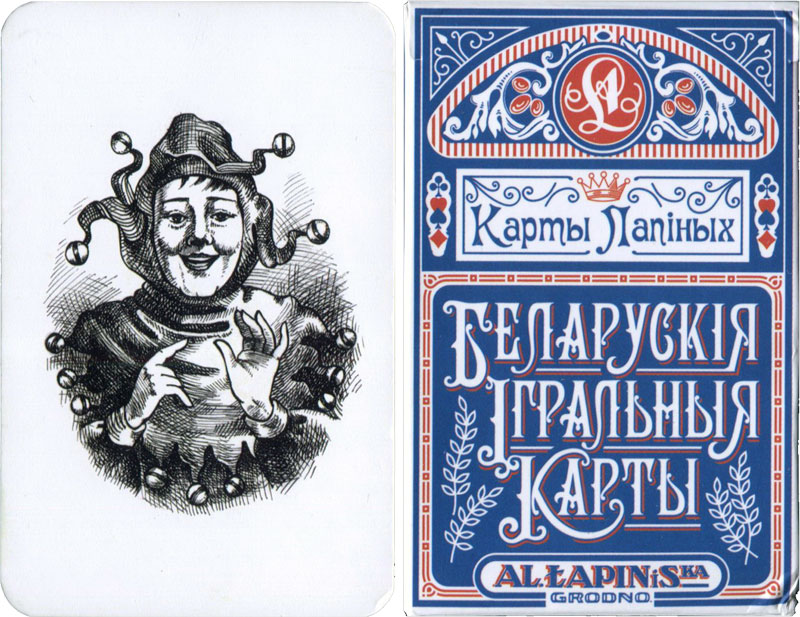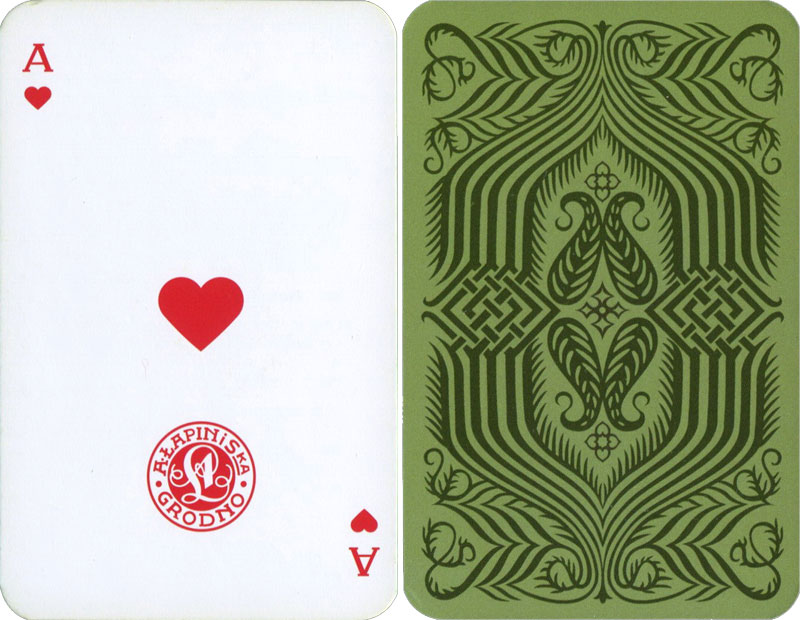Lapin Brothers
Reprint of Lapin’s Historical Belarusian playing cards.

Belarusian Lapin’s playing cards
Grodno (or Hrodna) is a city famous for its printing traditions. In early 1770s Antoni Tyzenhaus, who was its warden, took possession of a publishing house considered as one of the best letter foundries in the former Polish-Lithuanian Commonwealth territory.
In the mid-19th century there began to appear enterprises with an uncommon name - typolithographies, whose main business was to print lithographs. In 1879 the members of a wealthy lower middle class family, the Lapins, founded the first private typolithography. The owner’s name was Solomon Lapin. The establishment mainly printed cigarette labels, coloured advertisements and others.
In 1923 brothers Alexander and Abraham Lapin expanded their business and began to produce playing cards, which allowed them to rename their business as “First State Playing Card Factory”. The cards were of high quality and were used for playing such games as skat, bridge, poker and whist. The factory printed folk, Venitian and Rhenish cards. A unique deck depicting real kings was designed there as well, in which the kings represent real historical characters of Polish and Belarusian heritage - John Sobieski, Casimir III the Great, Sigismund II Augustus and Stephen Bathory.
In the autumn of 1939 the Lapin brothers’ factory was nationalized and its owners died in Grodno’s ghetto. The typography was repurposed for agitational materials instead. Until the early 1950s the factory in Grodno was the only colour printing enterprise in Soviet Belarus. It existed until 1993.

Above & right: Lapin’s playing cards with historical personages on the four kings, published by “А4”, printed by Onlineprint (Minsk), 2017. Size = 56х88 mm, 36 cards + 2 Jokers + booklet in box.
In 2017 the Yankouski family together with “A4” creative group took up the restoration of the Lapins’ playing cards. They were drawn by hand and restored based on the original deck fragments. On the pack one can see design features borrowed directly from the Lapins’ factory production: the logo, vignette and lettering.
The deck “with kings” shown here is unique because it was originally designed and printed only in Grodno.

By Valentin Krasavin (Валентин Красавин)
Member since January 05, 2014
Related Articles

Victorian grocer’s scale plate
Large flat plate decorated with highly coloured English cards and royal arms.

Royal Britain
Pack devised by Pietro Alligo depicting English monarchs from Alfred the Great to Elizabeth II.

Sissi playing cards
produced for the Austrian tourist market.

Sevilla 1647 reproduction
Facsimile of Spanish-suited pack produced in Sevilla, Spain, 1647.

English cards from the reign of Charles II
This article explores a historic pack of English playing cards from circa 1675, likely used by King ...

Le Monde Primitif Tarot
Facsimile edition produced by Morena Poltronieri & Ernesto Fazioli of Museo Internazionale dei Taroc...

Le Roi bridge
Reprint of a Piatnik (Budapest) pack of 1927 with Hungarian historical figures and scenic aces.

British Monarchs
Commemorating the royal wedding of Charles, Prince of Wales to Lady Diana Spencer on the 29th

Jeu Bonaparte
Jeu Bonaparte depicting the extended family of Napoleon Bonaparte, France, 1978

Jeu des Bonnets Phrygiens
Reproduction of Jeu des Bonnets Phrygiens relating to the Phrygian cap (or liberty cap), France, 198...

The Lovers playing cards
Reproductions of old postcards with romantic messages for Valentine’s Day.

Jeu Quatre Empereurs
Brazilian scenic aces with emperors of Brazil, Austria and France and other dignitaries on the court...

Portrait de Fribourg
Fine reproduction of a Fribourg pattern pack, originally by Jean-Jacques Burdel.

Kings and Queens of Brazil & Portugal
Historical playing cards by C. L. Wüst depicting monarchs of Brazil and Portugal.

FDR New Deal Deck
Facsimile of ‘FDR New Deal Deck’ of 1934 re-published by Bill Schroeder, USA, 2010.

Winstanley Geographical cards
Facsimile of Winstanley’s Geographical cards produced by Harold & Virginia Wayland, 1967.
Trending Articles
Popular articles from the past 28 days






